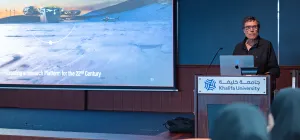IPF Has Strong Presence at Arctic Circle Assembly 2023

The International Polar Foundation had a very strong presence at the 10th edition of the annual Arctic Circle Assembly in Reykjavik, Iceland last week. Representatives from IPF managed a booth and participated in a number of panel discussions during the three days of the popular annual conference.
Featured speakers at breakout sessions
IPF Managing Director Nicolas Van Hoecke and IPF Systems Engineer Aymar de Lichtervelde, along with IPF Board Member, Former EU Arctic Ambassador, and Egmont Institute Senior Fellow Marie-Anne Coninsx took part in breakout sessions at the assembly.
On Thursday, October 19th Marie-Anne Coninsx led a panel discussion entitled, “Non-Arctic States: Assets for the Region” in which representatives from several Arctic Council observer states and states with interests in the Arctic gave their views on how they can contribute to the work of the Arctic Council and improving the quality of life of Arctic residents.
Then on Friday, October 20th, Marie-Anne Coninsx and Nicolas Van Hoecke participated in a panel discussion entitled "The Like-Minded, the Willing the Capable...the Belgians." This panel discussed Belgium's significant contributions to polar research since the 19th century, the Princess Elisabeth Antarctica (the world’s first zero-emission polar research station), the new Belgian polar research vessel, the Belgica, and Belgium's Arctic policy currently under development.
Also on Friday, Aymar de Lichtervelde spoke about deploying and operating renewable energy and water treatment technologies at the Princess Elisabeth Antarctica during a breakout session organized by US polar logistics firm Batelle and Icelandic vehicle firm Arctic Trucks.
Princess Elisabeth Antarctica featured at popular exhibition booth
During the entire conference, IPF also had a booth next to the entrance of the main auditorium at Harpa (where the Arctic Circle Assembly is held every year), exhibiting the green technologies used at the Princess Elisabeth Antarctica polar research station.
The booth highlighted the station’s new water treatment system (which recycles and reuses all wastewater at the station), as well as how renewable wind and solar energy sources are used to power the station. It also featured a scale model of PEA on Utsteinen Ridge in East Antarctica and a 3D-printed replica of PEA’s new water treatment system.
The booth also featured a few Belgian icons thanks to Jan Bayart, the Belgian Ambassador to Norway and Iceland: three Smurfs in the colours of the Belgian flag!
Many assembly participants visited the booth over the three days of the conference. Everyone was impressed with the solutions used at the station to significantly cut its environmental footprint. Visitors included entrepreneurs, investors, and most importantly residents of remote Arctic communities that need to ship in fuel, food, and even water on a regular basis at great cost. Having solutions such as a circular water treatment system and a smart grid that manages renewable wind and solar energy production could be very beneficial to remote Arctic communities.
Download





















